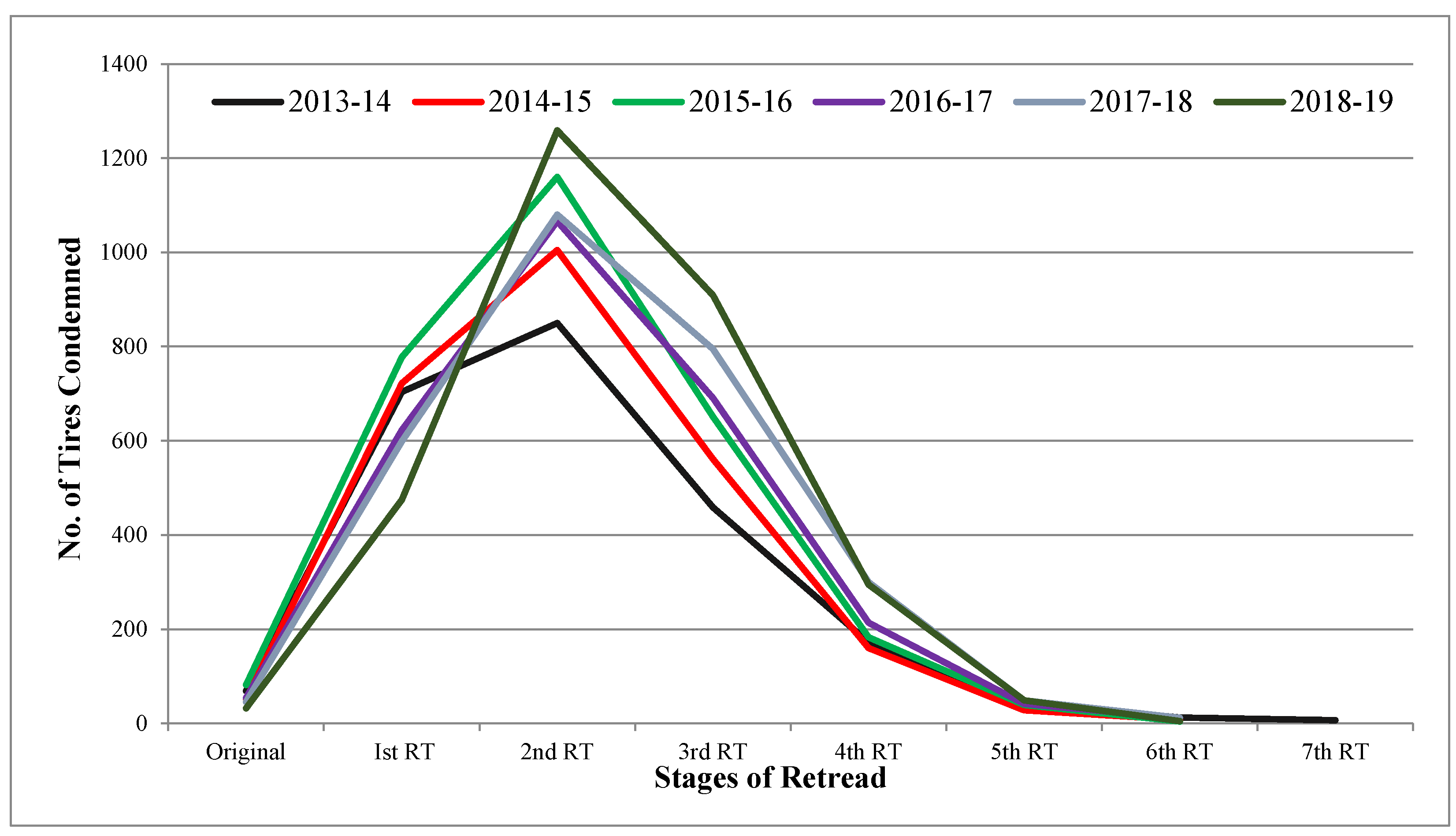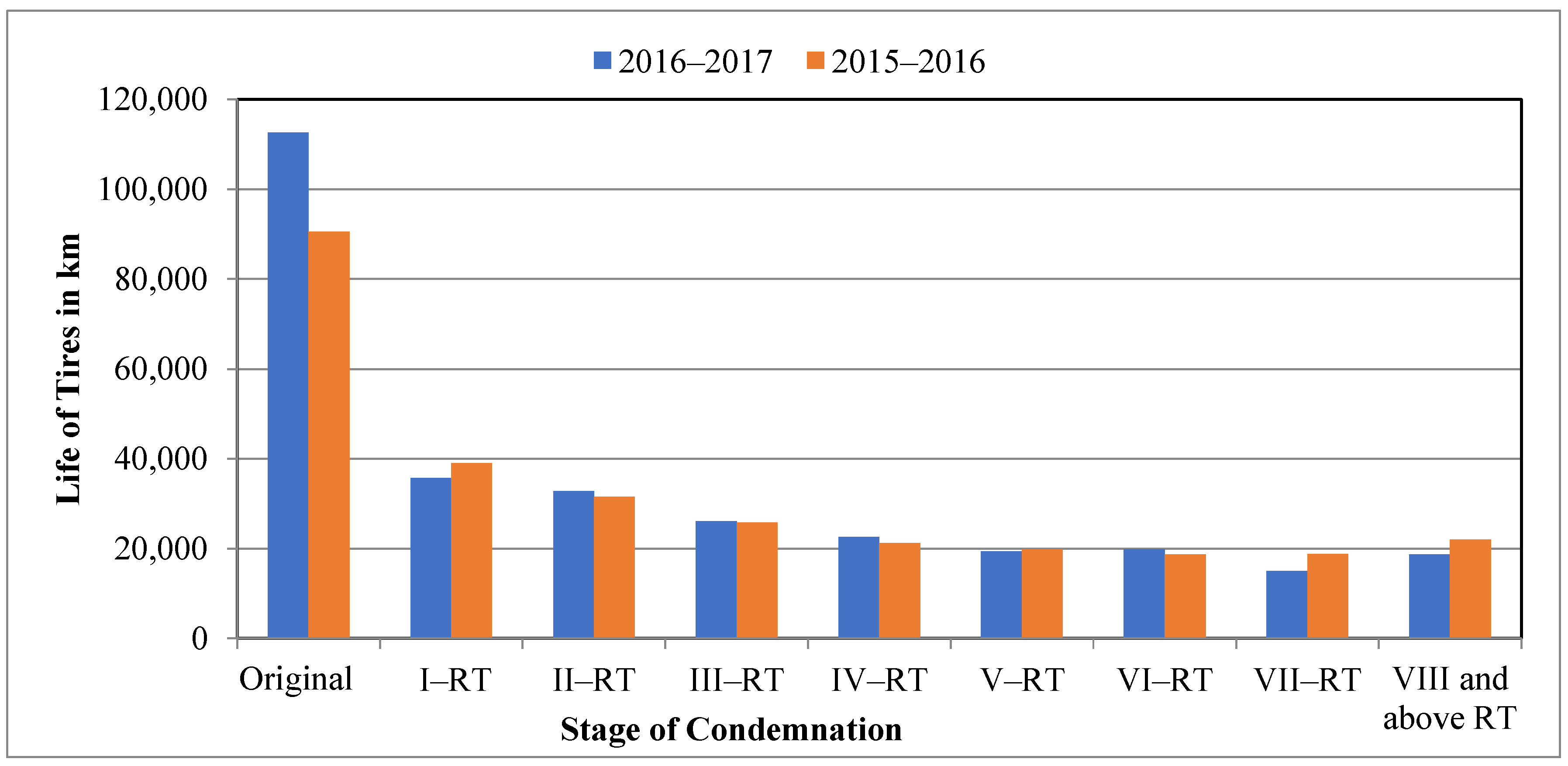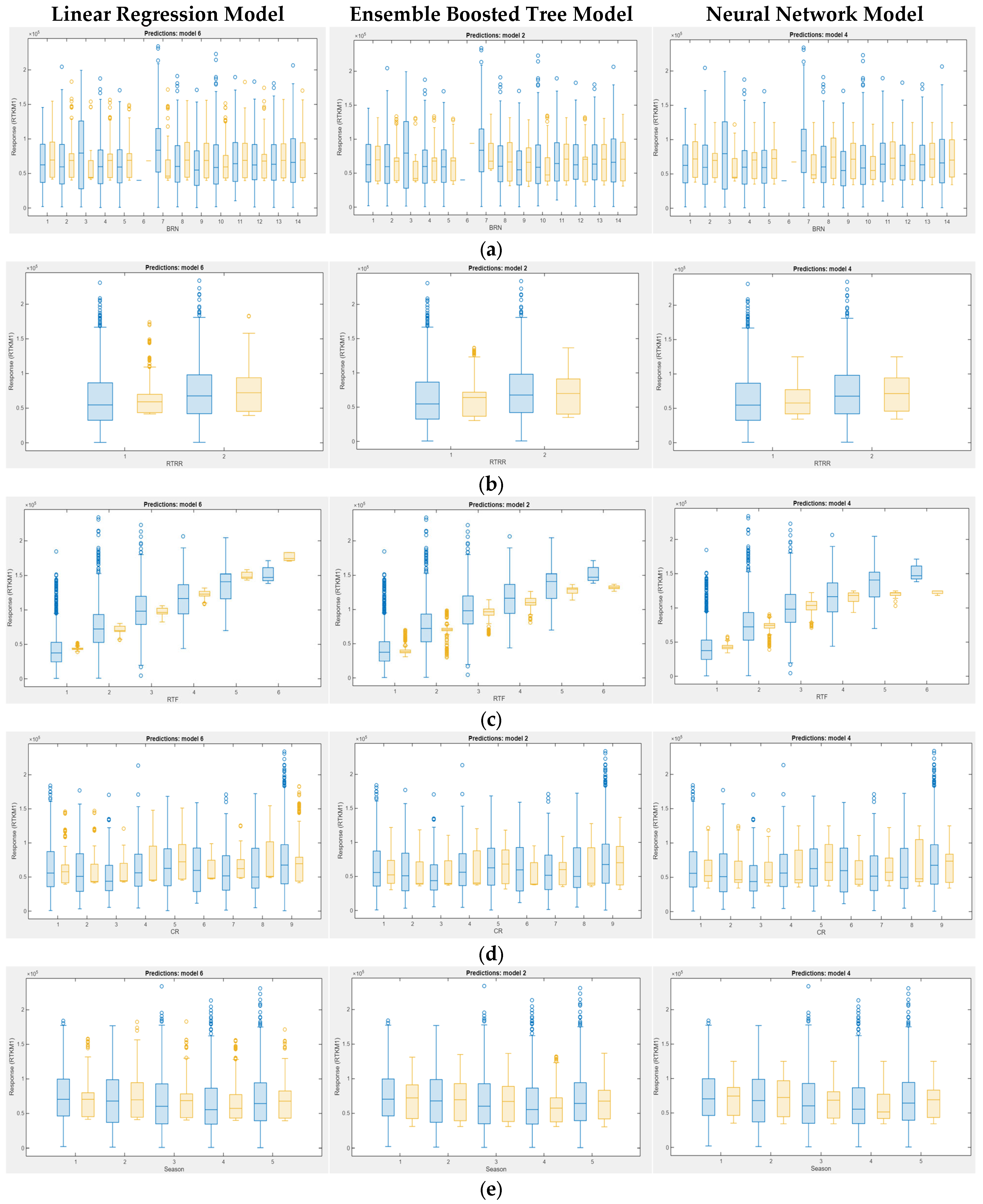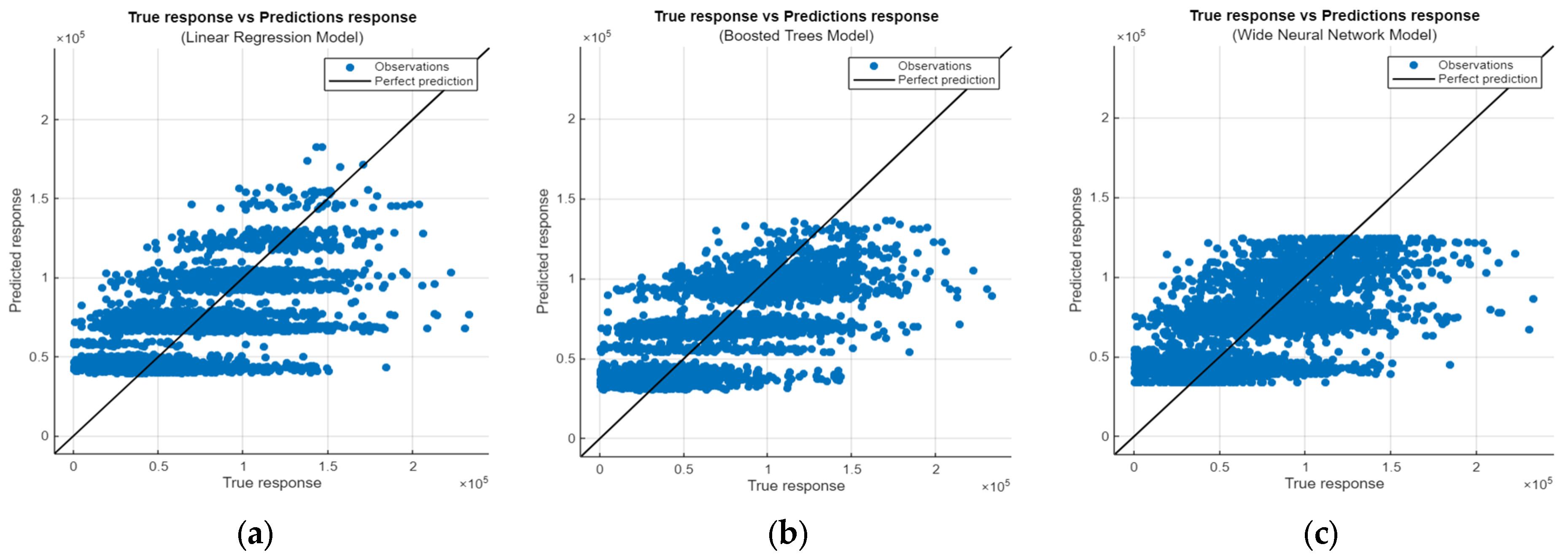The inspection stage in tire retreading is crucial, traditionally relying on worker expertise rather than scientific methods. Developing mathematical and machine learning prediction models incorporating lifespan-affecting variables is crucial to improving this process. These models aim to supplement manual inspection with scientific tools. This study focuses on 900 × 20 radial tires manufactured by JK Tyres in Chennai and retreaded in Viluppuram. It examines factors influencing the tire lifespan, excluding tread rubber quality due to its guaranteed performance and thus neutralizing its impact.
Building a Mathematical Model
The dataset spans six consecutive years of tire usage in the Viluppuram region. Over time, the mileage extracted from condemned tires has shown a gradual and continuous increase, possibly due to advancements in product development, process refinement in retreading, or maintenance practices. The mileage that could be extracted from each year’s tire casing was analyzed. This involved considering a statistical distribution of all condemned tires, excluding extremely low values indicative of new tire scrapping, and calculating the average (mean) kilometers obtained from the remaining tires. This average is denoted as M1, with ‘1’ representing the earliest year of data. Based on these considerations, two hypotheses were formulated to guide the development of our mathematical and predictive model. These hypotheses serve as foundational concepts for understanding mileage limitations and the impact of injuries on tire performance. Subsequently, two distinct scenarios were created based on these hypotheses, and their effects on the average kilometers yielded from condemned tires were evaluated.
Hypothesis 1. This can be assumed as the maximum mileage obtained from a tire casing for that year. If a tire yielded this or near this mileage from its new casing, even with zero injuries, it may fail in its first retread.
Hypothesis 2. This hypothesis suggests that the total mileage accumulated from new tires and retreads with new casings should not exceed Mn, where ‘n’ represents the year of data. In other words, if the mileage obtained from new tires is low, the cumulative mileage from retreads should be sufficiently high to avoid exceeding Mn. However, injuries to a tire casing can reduce the potential mileage, with the extent of the reduction depending on the number and size of injuries. More significant injuries and higher injuries result in a decreased mileage yield from retreads.
Scenario 1 Assumptions
- (a)
New tire failures are eliminated, and they achieve the population’s average mileage.
- (b)
Tires that gave 104 km or below get the respective retread stage average mileage.
- (c)
RT failures are eliminated to obtain the average mileage of the respective retread stage.
- a.
New Tire Failure Eliminated
If the number of new tires condemned is
, the average km obtained for the
population is
, and the overall population’s average mileage of
is achieved by
, the impact of a tire on the overall population will be
The total tire population condemned is . In this case, it is 32 (260,000 − 84,000)/3027 = 1861 km/tire. Let us denote it as A1.
- b.
Tires That Gave 104 or Lower
The total number of tires that gave 10
4 and fewer km is denoted by
. The suffix
L indicates the low-mileage population; in this study, it is 339 tires. Along with the suffix
L, if a number is denoted, it means the stage of retreading. For example,
will indicate the number of tires that gave 10
4 and fewer km in the first retread stage. The km obtained from each retread are denoted by
, with a suffix number indicating the number of times that tire was retreaded. For example,
shows the km obtained through the third retread. For the purposes of calculations, it is assumed that all tires are given 10
4 km. The additional km obtained are calculated using the following formula:
where
n is the maximum number of retreads. In this case, eight sixth RT tires with an average of 9600 km, less than 10
4 kms, are excluded. This equals 140,000/3027 = 3279 kms/tire. It is called
B1.
- c.
Retread Failures
denotes the number of tires that encountered a retread failure. In the case under study, it is 77 tires. In the suffix along with the letter, if a number is affixed, it indicates the stage of the retread. For example,
denotes the number of tires that failed at the fourth retread. It was assumed that these tires did not encounter a retread failure and had obtained the average kilometer yield in their respective stages of retread. The additional mileage obtained is calculated as follows:
In this case, it equals 2,054,400/3027 = 679 kms/tire, which is C1. Scenario I net benefit: The net additional km in Scenario I will be A1 + B1 + C1 = 1861 + 3279 + 679 = 5819 kms/tire, and the average condemned tire km will be 265,819 km. The tire requirement would have been (260,000/265,819) × 3027 = 2961 tires instead of 3027. Therefore, the resulting savings was 66 tires.
- (a)
New tire failures are eliminated and they achieve the first retreaded tires’ average mileage.
- (b)
It is assumed that tires capable of undergoing retreading can sustain one additional retread cycle.
- (c)
Retread failures are eliminated to obtain the respective RT stage mileage.
- (d)
Fifth and sixth retread tires remain unaltered in the redistribution as in these stages, RT failures occur, and the population needs to be higher.
- a.
New Tire Failure Eliminated
The additional mileage obtained is obtained using the following formula:
where
is the average first retreaded mileage, and the other notations are defined in Scenario I. It equals an additional 1543 km/tire, (W).
- b.
Population Redistribution
The letter capital
X will indicate the mileage, and the suffix of
X will show the retread stage. Thus,
will show the average mileage for the first retread stage. It includes the new tire mileage. Similarly,
will reveal the average mileage of the second retread tire population, including those new tires and first retread mileage. All other notations will be as in Scenario I. The additional mileage per tire is obtained from the following formula. Given the high retread failures and low volume, the redistribution is stopped with the third RT stage. The number of tires condemned in the fifth and sixth RT stages remains the same. This equals 13,134 additional kms/tire. Let us call it
Y.
- c.
Elimination of Retread Failures
The assumptions and procedures are the same as those outlined in Scenario I. This equates to 679 kms/tire. In Scenario I, this value was denoted as
C1. Therefore, the additional average expected is
W +
Y +
C1, which is 1543 + 13,134 + 679 = 15,356 kms/tire. Consequently, the expected average mileage will be 260,000 + 15,356 = 275,356 kms/tire, denoted as
. Upon assessing the net benefit of Scenario II and considering the predicted average condemned tire mileage of 275,356 km, the tire requirement is calculated as follows:
which is (260,000/275,356) × 3027 = 2858 tires. This means there is a saving of 169 tires (3027 − 2858).
The framework begins with data collection on key factors such as the casing integrity, depot conditions, injuries, seasons, and retread stages. The data, sourced from official records over a six-year period, undergo a rigorous preprocessing phase to ensure consistency and reliability. First, the independent variables are structured and categorized based on the predictor notations outlined in
Table 7, facilitating a standardized dataset. Missing values were carefully reviewed and removed only when they were found to occur randomly to avoid introducing bias through incorrect assumptions during imputation. Categorical variables were encoded using one-hot encoding to ensure compatibility with machine learning models. Outliers were identified using domain knowledge and the interquartile range method, and were handled accordingly to maintain the quality of the dataset. No data augmentation was applied so that the model could learn from real operating conditions. After manual checks for accuracy and completeness, the dataset was standardized using feature scaling and split into training, testing, and validation sets using stratified sampling to maintain class balance and ensure reliable model performance.
The depot or branch number (BRN) encompasses 14 distinct continuous values, each representing a different depot within the Viluppuram study area. The RT condition, denoted as RTRR, assumes 2 numeric variables for two conditions: WO and WR. WO signifies “without injury,” while WR encompasses all other conditions. The retread condition is numerically categorized as 1 or 2, indicating the absence or presence of injury. The third variable, retread stage (RTF), ranges from one to six, reflecting the maximum of six achieved retread stages observed in our study. The influence of different seasons on the situation was also noted, with the five most prevalent seasons in the study area represented by the numerical values one to five. Lastly, the retreading tire condition or tire status (CR) is categorized into 10 categories. These categories denote various conditions of the tire, ranging from KO1 for a one-inch patch to CO8 for a run-flat or shoulder injury. A serviceable tire is classified under CO9, while those without injuries receive a numeric value of 10. The road condition, vehicle load variation, and driver behavior were not explicitly included in the model for several reasons. Road conditions in Tamil Nadu are relatively consistent due to standardized road infrastructure development, resulting in minimal variability across depots. Vehicle load variation is not a critical factor for bus operations, as buses have dynamic passenger loading, unlike trucks with fixed cargo weights. Similarly, driver behavior, though relevant for a broader maintenance analysis, does not significantly impact the prediction of retread maintenance, which primarily depends on the tire condition, depot practices, and retread history. Therefore, the selected variables provide a robust framework for accurately predicting retread performance without the need for these dynamic factors.
Among these 6 variables, the first 5 are independent variables, while RTKM1 (retreaded kilometers) is the dependent variable for developing the machine learning model. The dataset is divided into three subsets: 70% for training, 15% for validation, and 15% for testing. The cross-validation method was employed to systematically evaluate multiple machine-learning algorithms for prediction. Using MATLAB’s version R2023b Regression Learner App from the Statistics and Machine Learning Toolbox, the dependent and independent variables were inputted, and various regression models were trained and compared. This app facilitates automated model selection by assessing performance metrics such as RMSE, R2, and MAE across multiple models. Based on these evaluations, the most suitable models—linear regression, ensemble (boosted trees), and neural network regression—were chosen. All model training and evaluations were conducted on a system equipped with an Intel Core i7 (11th Gen, 2.80 GHz) processor and 16 GB of RAM, running Windows 10, ensuring computational efficiency during model development.
The selection was driven by the interpretability, computational efficiency, and predictive accuracy observed in the dataset. Random Forest (RF), while effective at handling non-linearity, was found to be computationally intensive for large-scale deployment in this context. Support Vector Machines (SVMs) were tested, but they exhibited longer training times and lacked a significant performance improvement over the selected models. Deep Learning (DL) models, despite their ability to capture complex patterns, require extensive data and computational resources, making them less practical for this specific predictive task. Therefore, the chosen models strike a balance between accuracy, interpretability, and computational feasibility, ensuring robust and scalable predictions. To assess the model’s accuracy and compare its outcomes with both the predicted and actual values, the coefficient of determination (R
2) was utilized. This metric evaluates the linear model’s goodness of fit and quantifies the model’s explained variation, commonly employed in a regression analysis [
28]. The R
2 value is calculated from the following equation:
Certainly, R2 is a statistical metric indicating the proportion of variance explained by one or more independent variables in a regression model. Its typical range is from 0 to 1 , with higher values, suggesting a better fit of the model to the data. A detailed comparison of the performance of the three models utilized in this study is presented hereafter.
















